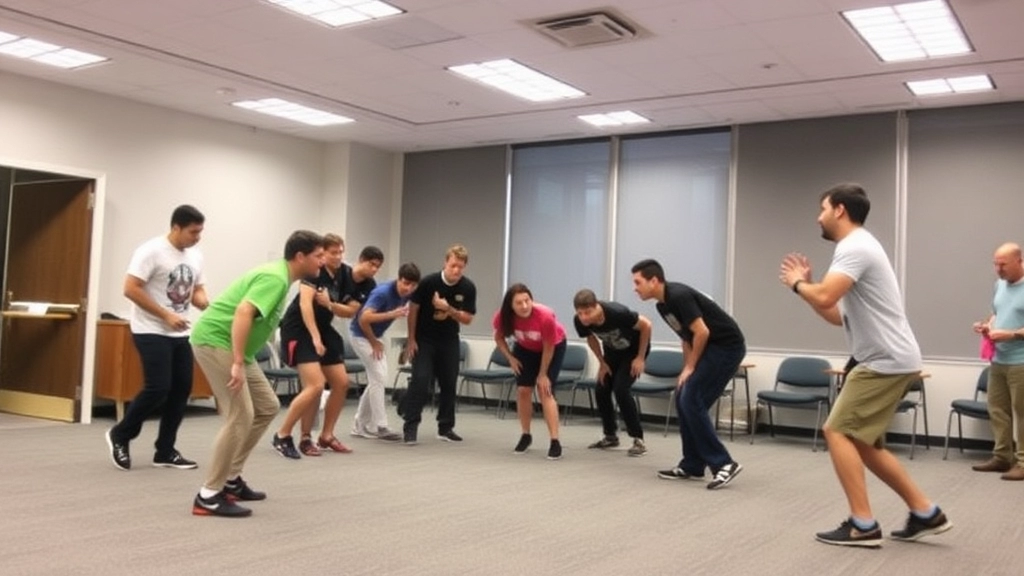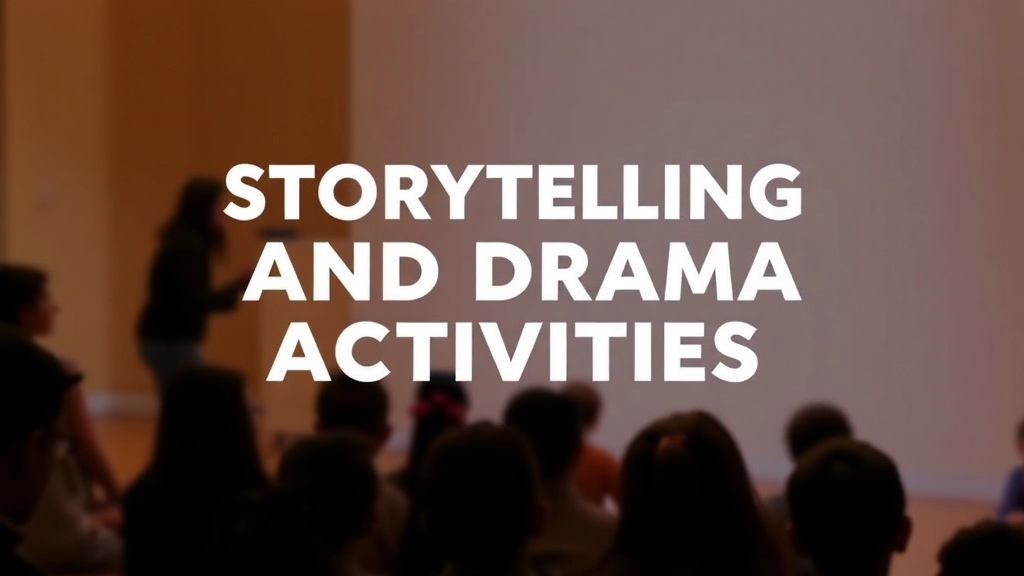Welcome to the Ultimate Guide on Summer Camp Activities Indoor!
Whether you’re a camp coordinator, a parent, or simply someone looking to keep the fun rolling indoors, this article has got you covered. From creative arts and crafts projects to technology and coding challenges, we’ve compiled a diverse list of activities that cater to all interests and age groups. We’ll explore how each activity not only entertains but also fosters skills like teamwork, creativity, and mindfulness. Ready to transform those indoor days into unforgettable experiences? Let’s dive in!
Imagine a Summer Camp Where Fun Never Stops
Picture kids and adults alike engaging in educational workshops, grooving to music and dance sessions, or getting their hands dirty with science experiments. This guide will walk you through ten exciting categories of indoor activities, each designed to keep the energy high and the boredom at bay. From indoor sports to cultural and themed events, you’ll find ideas that are both entertaining and enriching. So, buckle up and get ready to discover the endless possibilities of summer camp activities indoor!
Creative Arts and Crafts Projects
Alright, let’s dive into creative arts and crafts projects. You know, sometimes we all need a break from the usual grind. Whether it’s for kids, adults, or teams looking to bond, arts and crafts can be a game-changer. So, what’s the deal with these projects, and why should you care? Let’s break it down.
Why Bother with Arts and Crafts?
You might be thinking, “Why should I invest time in arts and crafts?” Here’s the scoop:
- Stress Relief: Doodling, painting, or crafting can seriously lower stress levels.
- Boosts Creativity: It’s like a workout for your brain. The more you create, the more creative you become.
- Team Building: Working on a project together can strengthen relationships and improve teamwork.
- Skill Development: You pick up new skills, like hand-eye coordination, problem-solving, and even patience.
Types of Projects to Dive Into
There’s a ton of stuff you can do. Here are some ideas to get your creative juices flowing:
- Painting and Drawing:
- Watercolours: Easy to get started, and the results can be stunning.
- Acrylics: Great for bold, vibrant colours.
- Sketching: Perfect for those who love detail.
- DIY Crafts:
- Scrapbooking: A fantastic way to preserve memories.
- Jewellery Making: Create your own accessories.
- Home Décor: Think homemade candles, wall hangings, or custom picture frames.
- Sculpting and Modelling:
- Clay Modelling: From pottery to small figurines.
- Paper Mache: Great for kids and adults alike.
- Textile Crafts:
- Knitting and Crocheting: Not just for granniesâthese are super relaxing.
- Sewing: Make your own clothes or home items.
Real-Life Example: My First Scrapbooking Adventure
Let me share a quick story. I once decided to start scrapbooking. I gathered old photos, tickets, and little mementos from trips. At first, it was a bit overwhelming. But as I got into it, I found it incredibly therapeutic. Plus, I ended up with a beautiful book of memories that I can look back on anytime.
Tips to Get Started
- Gather Supplies: Make a list of what you need and get everything in one go.
- Set Up a Workspace: Find a quiet, comfortable place to work.
- Start Simple: Don’t go overboard with complicated projects right away.
- Watch Tutorials: YouTube is your best friend here.
- Join a Group: Look for local or online communities to share ideas and get feedback.
If you’re looking for more structured activities, consider exploring some art summer camps that offer a variety of creative projects. Additionally, for those who love the outdoors, check out these bucolic summer camps for a nature-filled adventure.
Indoor Team-Building Games

Ever felt like your team’s just not clicking?
Maybe you’re all stuck indoors, and the vibe’s a bit off.
Indoor team-building games could be your golden ticket.
These games are perfect for breaking the ice and boosting morale.
Let’s dive in.
Why Indoor Team-Building Games?
Team-building games are not just for fun.
They help build trust, improve communication, and boost productivity.
Plus, they’re a great way to get to know each other better.
Think of it as a mini adventure without leaving the room.
Types of Indoor Team-Building Games
Here’s a list of some killer indoor games that can transform your team dynamics:
- Escape Room Games: Solve puzzles and find clues to ‘escape’ the room. Perfect for problem-solving and teamwork.
- Trivia Quizzes: Test your team’s knowledge on various topics. It’s fun and educational.
- Charades: Act out words or phrases without speaking. Great for non-verbal communication.
- Two Truths and a Lie: Share two truths and one lie about yourself. Others guess which is the lie. Builds trust and breaks the ice.
- Human Knot: Stand in a circle, grab hands with two different people, and try to untangle without letting go. It’s all about teamwork and communication.
Benefits of Indoor Team-Building Games
So, why bother?
Here’s why:
- Improved Communication: You’ll talk more, and not just about work.
- Stronger Relationships: You’ll get to know your colleagues better.
- Increased Motivation: A happy team is a productive team.
- Enhanced Problem-Solving Skills: You’ll learn to think on your feet.
Real Stories, Real Impact
I remember this one time we did an escape room at the office.
We were stuck on a puzzle for ages.
But then, Jane from accounting had this brilliant idea.
We solved it and escaped with just seconds to spare.
The high-fives and cheers were unforgettable.
And guess what?
We worked better together after that.
Educational Workshops and Classes
Ever feel like your team’s stuck in a rut? Or maybe you’re just tired of the same old routine and want to shake things up? Trust me, I’ve been there. That’s where educational workshops and classes come in. They’re not just about learning; they’re about sparking creativity, boosting morale, and fostering a sense of community. Let’s dive into why these workshops are a game-changer and how you can make the most out of them.
Why Educational Workshops?
First off, why even bother with workshops and classes? Here are a few reasons:
- Skill Development: Whether it’s coding, public speaking, or even cooking, these sessions can help your team pick up new skills.
- Team Bonding: Learning together can break down barriers and build stronger relationships.
- Creative Boost: New skills can lead to new ideas and fresh perspectives.
- Morale Booster: A break from the usual grind can re-energize your team.
Types of Workshops to Consider
Alright, so what kinds of workshops should you be looking at? Here’s a quick list to get you started:
- Coding and Technology: Perfect for teams looking to up their tech game. Think Python, JavaScript, or even basic web development.
- Public Speaking and Communication: Great for enhancing presentation skills and boosting confidence.
- Creative Writing: Ideal for sparking creativity and improving storytelling abilities.
- Art and Design: From graphic design to painting, these workshops can unleash the artist in everyone.
- Health and Wellness: Yoga, meditation, and nutrition classes can promote a healthier lifestyle.
How to Make It Engaging
Now, let’s talk about how to keep these workshops engaging. No one wants to sit through a boring lecture, right? Here are some tips:
- Interactive Activities: Break up the monotony with group activities and hands-on projects.
- Guest Speakers: Bring in experts to share their insights and experiences.
- Real-Life Examples: Use case studies and real-world scenarios to make the content relatable.
- Q&A Sessions: Allow time for questions and discussions to keep everyone involved.
Real-Life Example
Let me share a quick story. I once organised a public speaking workshop for my team. Initially, everyone was hesitant. Public speaking isn’t exactly everyone’s cup of tea. But by the end of the session, people were not only more confident but also more connected. We even had a mini competition where everyone had to present a topic of their choice. The results were phenomenal. People who barely spoke up in meetings were now leading discussions. It was a game-changer.
Internal Linking Opportunities
To make the most out of these workshops, consider pairing them with other activities. For example, after a coding workshop, you could dive into Technology and Coding Challenges. Or, follow up a public speaking class with Storytelling and Drama Activities to put those new skills into practice.
Indoor Sports and Physical Activities

Ever feel cooped up indoors and itching for a bit of action?
I get it.
We all need to move, especially when we’re stuck inside.
Here’s the good news: you can still get your heart pumping without stepping outside.
Indoor sports and physical activities are the answer.
Why Bother with Indoor Sports?
First off, you don’t need a massive space.
Your living room, a hallway, or even a garage can work wonders.
Plus, you won’t have to worry about the weather messing up your plans.
Quick and Easy Indoor Sports Ideas
- Mini Basketball:
- Grab a mini hoop and a foam ball.
- Set it up on a door.
- Challenge your mates to a shooting contest.
- Table Tennis:
- A table, a net, a couple of paddles.
- Instant fun.
- Great for reflexes and hand-eye coordination.
- Indoor Football:
- Use a soft ball.
- Create goals with whatever you have around.
- Keep it friendly to avoid breaking stuff.
- Yoga and Stretching:
- Not just for flexibility but also for strength.
- Follow a YouTube tutorial.
- Perfect for winding down after a long day.
Team Building with Indoor Sports
Indoor sports aren’t just about solo play.
They’re brilliant for team building too.
Think about it.
A bit of friendly competition can break the ice and boost morale.
Organise a Mini-Tournament
- Choose Your Sport:
- Could be anything from dodgeball to badminton.
- Set Up Teams:
- Mix it up so everyone gets to know each other.
- Keep Score:
- A little competition never hurt anyone.
- It makes it more engaging.
Stay Active with Limited Space
Not everyone has a gym at home.
But that’s no excuse.
You can still stay active.
Bodyweight Exercises
- Push-ups, sit-ups, squats.
- No equipment needed.
- Do them in sets and reps.
Dance Workouts
- Follow a dance routine online.
- Fun and effective.
- Great for cardio.
Skipping Rope
- Simple but effective.
- Burns calories fast.
- Just watch out for the ceiling!
Music and Dance Sessions
Alright, let’s get real. Ever felt like your indoor events are missing that spark? You know, the kind of energy that gets everyone moving and grooving? Well, that’s where Music and Dance Sessions come into play. We’re talking about turning a dull afternoon into a high-energy, fun-filled experience. So, why should you care about adding music and dance to your activities? Let’s dive in.
Why Music and Dance?
First off, music and dance aren’t just for fun â they’re powerful tools for connection and expression. They break down barriers, foster creativity, and boost morale. Think about it: ever seen someone frown while dancing? Exactly.
Benefits of Music and Dance Sessions
Here are some solid reasons to incorporate music and dance into your indoor activities:
- Boosts Mood and Energy: Music has this magical ability to lift spirits and get people moving. A lively dance session can turn a sluggish group into an energetic one.
- Enhances Team Bonding: Dancing together creates a sense of unity. It’s an excellent way to build camaraderie and trust among participants.
- Encourages Creativity: Both music and dance allow for personal expression. Participants can get creative with their moves and feel more confident.
- Improves Physical Health: Dancing is a great workout. It improves cardiovascular health, flexibility, and coordination.
Types of Music and Dance Sessions
Now, let’s break down some types of sessions you can organise. Remember, it’s all about keeping it fresh and engaging.
Dance-Off Competitions
Who doesn’t love a little friendly competition? Organise a dance-off where participants can showcase their best moves. You can even have different categories like solo, duo, and group performances. Trust me, the energy will be off the charts.
Themed Dance Parties
Pick a theme â 80s disco, Bollywood night, or even a masquerade ball. Themed dance parties are a hit because they add an element of excitement and anticipation. Plus, everyone loves dressing up.
Music Workshops
Not everyone is a born dancer, and that’s okay. How about a music workshop where participants can learn to play an instrument or even create their own music? It’s a fantastic way to engage those who might be a bit shy on the dance floor.
Choreography Sessions
Hire a professional choreographer to teach a dance routine. This can be super fun and challenging. By the end of the session, everyone will feel accomplished and ready to perform.
Silent Disco
Ever tried a silent disco? Participants wear headphones and dance to their own beat. It’s quirky, fun, and a great way to cater to different music tastes.
Real Stories, Real Impact
Let me share a quick story. We once organised a silent disco at a corporate retreat. Initially, people were hesitant, but once they put on those headphones, the place lit up. By the end, even the most reserved participants were dancing like no one was watching. The feedback? “Best team-building activity ever!”
Tips for a Successful Session
Alright, here are some quick tips to ensure your music and dance sessions are a hit:
- Know Your Audience: Tailor the music and dance style to the preferences of your group.
- Explore Bucolic Summer Camps: Ensure the space is inviting and non-judgmental. Encourage everyone to participate, but don’t force it.
- Use Quality Equipment: Good sound quality is crucial. Invest in decent speakers or headphones if you’re doing a silent disco.
- Summer Camp Aesthetic: A 30-45 minute session is usually perfect. Enough to get everyone moving without exhausting them.
Storytelling and Drama Activities

Ever wondered how to make a rainy day indoors exciting for everyone?
Storytelling and drama activities might just be your answer.
They’re not just fun; they’re a fantastic way to spark creativity and boost confidence.
Why Storytelling and Drama?
Storytelling is more than just reading a book.
It’s about bringing characters to life and diving into different worlds.
Drama activities? They take it a step further.
Think role-playing and acting out scenes.
Both are brilliant for:
- Improving communication skills
- Enhancing imagination
- Building empathy
Activities to Try
1. Improvisation Games
These are a blast.
You don’t need a script.
Just a scenario and let everyone’s imagination run wild.
2. Puppet Shows
Got some old socks or paper bags?
Turn them into puppets.
Create a story together and perform it.
3. Story Circles
Start a story and let each person add a line.
The twists and turns will surprise you.
4. Scripted Plays
Pick a short play or write one.
Assign roles and rehearse.
Then, put on a mini-performance.
Real-Life Examples
Last week, we had a rainy day.
Instead of the usual boredom, we tried improv games.
One person started as a pirate, another as a lost tourist.
The laughs were endless.
And guess what?
Everyone felt more connected by the end of it.
Tips for Success
- Keep it simple: You don’t need fancy props or costumes.
- Encourage everyone: Even the shy ones. They often have the best ideas.
- Mix it up: Rotate between storytelling and drama activities to keep things fresh.
Science and Discovery Experiments
Ever wondered how to make science fun for everyone? Or maybe you’re worried that your kids are spending too much time on screens and not enough time exploring the world around them? If so, you’re not alone. Many of us are looking for ways to engage our children in meaningful, hands-on activities that spark curiosity and a love for learning. That’s where science and discovery experiments come in.
Why Science Experiments Matter
Science experiments aren’t just about mixing chemicals or watching things explode (although that’s pretty cool too). They’re about engaging curiosity, critical thinking, and problem-solving skills. Plus, they’re a fantastic way to bond with your kids or students while making learning fun.
Easy and Exciting Science Experiments to Try at Home
You don’t need a lab coat or fancy equipment to get started. Here are some easy-to-do experiments that you can try at home:
-
Volcano Eruption
- Materials: Baking soda, vinegar, food colouring, and a container.
- Steps:
- Fill the container with baking soda.
- Add a few drops of food colouring.
- Pour in the vinegar and watch the eruption!
- Why it works: This classic experiment demonstrates an acid-base reaction.
-
Invisible Ink
- Materials: Lemon juice, cotton swabs, white paper, and a heat source (like a lamp).
- Steps:
- Dip the cotton swab in lemon juice and write a message on the white paper.
- Allow the paper to dry.
- Hold the paper close to a heat source to reveal the hidden message.
- Why it works: The heat causes the lemon juice to oxidize and turn brown, revealing the message.
-
Density Rainbow
- Materials: Various liquids like honey, dish soap, water, vegetable oil, and rubbing alcohol.
- Steps:
- Carefully layer each liquid in a clear glass.
- Observe the different layers forming a rainbow.
- Why it works: Each liquid has a different density, causing them to layer instead of mix.
Linking Science to Everyday Life
One of the best parts about science experiments is that they can be linked to everyday life. For instance, you can explain the baking soda and vinegar reaction in the context of cooking or cleaning. This makes the learning process more relatable and memorable.
Incorporating Technology
If you’re tech-savvy, consider incorporating technology into your science experiments. Use apps that simulate scientific phenomena or allow kids to document their findings digitally. This not only makes the activity more engaging but also teaches them valuable tech skills.
Real-Life Stories
I remember when I first did the volcano eruption experiment with my nephew. His eyes lit up with amazement, and he couldn’t stop talking about it for days. It was a simple experiment, but it sparked his interest in science, leading him to ask more questions and want to learn more. For more creative ideas to keep kids engaged, check out our creative summer camp themes.
Additionally, if you’re looking for ways to incorporate more learning activities into your summer plans, our guide on exciting summer camp activities offers a wealth of ideas to keep the curiosity and learning going.
Mindfulness and Relaxation Practices

Ever feel like life’s just too hectic?
Wondering how to find a moment of peace in the chaos?
You’re not alone.
Why Mindfulness Matters
Mindfulness isn’t just a buzzword.
It’s a real way to calm the mind and reduce stress.
Here’s how you can start:
- Breathing Exercises: Focus on your breath. Inhale deeply, exhale slowly. Repeat.
- Guided Meditation: Apps like Headspace or Calm can guide you through it.
- Body Scans: Lie down, close your eyes, and mentally scan your body from head to toe.
Relaxation Techniques
Feeling tense?
Try these:
- Progressive Muscle Relaxation: Tense each muscle group, then release.
- Visualisation: Picture a peaceful place. Imagine you’re there.
- Mindful Walking: Walk slowly, notice each step and the world around you.
Making It a Habit
Consistency is key.
Here’s how to stick with it:
- Set a Routine: Same time, same place, every day.
- Start Small: Even 5 minutes can make a difference.
- Track Your Progress: Use a journal or an app.
Real Stories
I remember a friend who was always stressed.
She started with just 5 minutes of meditation a day.
In a month, she was a different person—calmer, happier.
Technology and Coding Challenges
Alright, let’s talk about technology and coding challenges. Ever wondered how to keep kids or even adults engaged in a meaningful way indoors? Or how to make sure they’re not just glued to mindless screen time? These are real questions I get all the time. Let’s dive into it.
Why Technology and Coding?
First off, why should we even bother with technology and coding? Well, it’s simple. The world is moving at a breakneck pace towards digital everything. If you don’t get on board now, you might just get left behind. Coding isn’t just for the tech geeks anymore; it’s becoming as fundamental as reading and writing.
Benefits of Coding Challenges
You might be thinking, âCoding sounds complicated!â But hear me out. Coding challenges are not only fun but also super beneficial. Here’s why:
- Problem-Solving Skills: Coding forces you to think logically and solve problems step by step.
- Creativity: Believe it or not, coding can be incredibly creative. You’re building something from scratch!
- Future-Ready Skills: Knowing how to code is a massive advantage in today’s job market.
- Teamwork: Many coding challenges require collaboration, which is perfect for team-building.
How to Get Started
Now, you’re probably wondering how to even start with this stuff. Don’t worry; it’s easier than you think.
- Choose the Right Platform: Websites like Code.org, Scratch, and Khan Academy are fantastic for beginners.
- Set Clear Goals: Start with simple projects like creating a basic game or an interactive story.
- Use Tutorials: There are tons of free tutorials online. YouTube is a goldmine for this.
- Join a Community: Platforms like GitHub or even local coding clubs can provide support and inspiration.
Making It Fun
Let’s keep it real. If it’s not fun, no one’s going to stick with it. Here’s how to keep the excitement alive:
- Gamify the Experience: Turn coding challenges into a game. Offer rewards or create a leaderboard.
- Real-World Projects: Work on projects that have real-world applications. Maybe a website for a local charity or a simple app for a community event.
- Collaborative Challenges: Pair up participants to work on projects together. This not only eases the learning curve but also makes it more enjoyable.
Stories and Examples
Let me share a quick story. I once had a group of kids who were more interested in playing video games than learning anything new. So, I challenged them to create their own simple game. At first, they were skeptical, but once they saw their characters moving on the screen, they were hooked. By the end of the week, they were asking for more advanced projects. It’s all about making it relatable and fun.
Overcoming Common Challenges
Of course, it’s not all sunshine and rainbows. You might hit some bumps along the way.
- Frustration with Bugs: Debugging can be a nightmare. Teach them to see it as a puzzle rather than a problem.
- Lack of Interest: If someone’s not interested, find out what they are passionate about and tailor the projects accordingly.
- Resource Limitations: Not everyone has access to high-end computers. Many coding platforms work just fine on basic setups.
Cultural and Themed Events
Ever wondered how to spice up indoor activities?
Cultural and themed events are a game-changer.
They bring excitement, engagement, and learning all in one package.
Why Cultural and Themed Events?
People crave variety.
Sticking to the same routine gets boring fast.
Cultural and themed events break that monotony.
They offer something new and exciting.
Types of Themed Events
- International Days: Celebrate different countries with food, music, and customs.
- Historical Reenactments: Dive into history with costumes and storytelling.
- Holiday Celebrations: Go big on Halloween, Christmas, or any other holiday.
- Fantasy Worlds: Think Harry Potter, Star Wars, or any popular universe.
How to Plan a Themed Event
Planning can be overwhelming.
But here’s a simple way to do it:
- Choose a Theme: Decide what you want to focus on.
- Set a Date: Pick a day that works for everyone.
- Gather Materials: Decorations, costumes, and props.
- Plan Activities: Games, food, music, and crafts related to the theme.
- Invite Participants: Get the word out early.
Real Stories
Last year, we hosted an “Around the World” event.
Each room was a different country.
We had Italian pizza, Japanese sushi, and Brazilian samba.
Everyone loved it.
Benefits of Themed Events
- Educational: Learn about different cultures.
- Interactive: Lots of hands-on activities.
- Social: Great for team building and making new friends.
- Fun: Who doesn’t love a good party?
Quick Tips
- Mix It Up: Don’t stick to just one type of event.
- Get Feedback: Ask participants what they liked and didn’t like.
- Be Inclusive: Make sure everyone feels welcome.
Cultural and themed events are the way to go.
Ready to take the plunge? Check out our Top Summer Camp Games and Activities Guide for more ideas on making your events engaging. Also, don’t miss our Eye-catching Summer Camp Flyers Tips & Ideas to promote your next big event!
FAQs on Summer Camp Activities Indoor
What are some good indoor team-building games for summer camps?
Indoor team-building games like Escape Room Games, Trivia Quizzes, Charades, Two Truths and a Lie, and Human Knot can help break the ice and boost morale among participants.
Why should we consider indoor team-building games?
Indoor team-building games are not just fun; they help build trust, improve communication, and boost productivity. They also provide a way to get to know each other better.
What are the benefits of indoor sports at a summer camp?
Indoor sports can improve physical fitness, provide a fun activity regardless of weather conditions, and offer opportunities for team building through friendly competition.
Can you suggest some quick and easy indoor sports activities?
Some easy indoor sports activities include Mini Basketball, Table Tennis, Indoor Football, and Yoga and Stretching. These activities require minimal space and equipment.
How can storytelling and drama activities be beneficial in a summer camp setting?
Storytelling and drama activities can spark creativity, boost confidence, improve communication skills, enhance imagination, and build empathy among participants.
What are some engaging storytelling and drama activities?
Engaging activities include Improvisation Games, Puppet Shows, Story Circles, and Scripted Plays. These activities encourage creativity and participation from all campers.
Why is mindfulness important even at a summer camp?
Mindfulness helps calm the mind and reduce stress. It can provide a moment of peace amidst the busy camp schedule, helping campers feel more relaxed and focused.
What are some simple mindfulness and relaxation practices?
Simple practices include Breathing Exercises, Guided Meditation, Body Scans, Progressive Muscle Relaxation, Visualisation, and Mindful Walking. These can easily be incorporated into the camp routine.
How can we ensure participants stick with mindfulness practices?
To ensure consistency, set a routine, start with small sessions (even 5 minutes can make a difference), and track progress using a journal or an app.
References
-
15 Indoor Team-Building Activities That Can Boost Employee Morale
-
Top 10 Team Building Games
-
6 Fun and Powerful Team Building Activities

